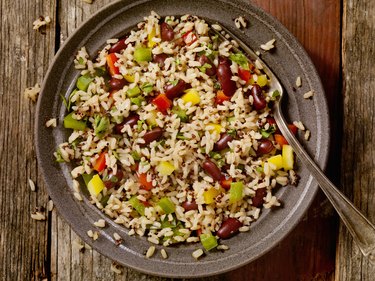
Hemorrhoids are nobody's idea of a good time — and anyone who has them is likely looking for ways to avoid flare-ups. If you're a fan of fiber and wondering if it can cause hemorrhoids, you can rest easy: High-fiber foods don't cause hemorrhoids, and they can actually help prevent them.
Hemorrhoids are itchy, painful and sometimes bloody swollen veins located in the anus and lower rectum region, according to the Mayo Clinic. They can form internally (inside the rectum) or externally (beneath skin surrounding the anus). And nearly 75 percent of all adults will develop them at some point in one form or another.
Video of the Day
Video of the Day
Related Reading
How Fiber Fights Hemorrhoids
As for whether eating too much fiber could cause hemorrhoids, the answer is plainly no. Quite the contrary. In fact, alongside chronic diarrhea, chronic constipation, obesity, pregnancy, anal sex, old age and routine heavy lifting, the Mayo Clinic cites eating a diet too low in fiber as one potential cause for developing hemorrhoids.
"Hemorrhoid incidence is largely due to straining time on the toilet," says Dunedin, New Zealand-based Andrew Reynolds, BSc, MSc, a postdoctoral research fellow with the Department of Medicine at the University of Otago. Translation: The longer and more arduous the act of attending to No. 2, the greater the risk for hemorrhoids.
Plus, "the amount of straining necessary to pass stools can be related to insufficient dietary fiber intake," Reynolds says, rather than too much fiber.
That's why hemorrhoid management advice "is normally to increase dietary fiber intake and drink plenty of water," Reynolds says. Fiber and water help soften stools, which, in turn, mean less time spent on the toilet. That means a lower risk for developing hemorrhoids, for continued irritation of any existing hemorrhoids or for bloody stools.
Adults should aim for 14 grams of dietary fiber for every 1,000 calories they eat, according to the Dietary Guidelines for Americans 2020-2025, or about 20 to 30 grams per day total.
High-Fiber Food Options
Per the National Institute of Diabetes and Digestive and Kidney Diseases (NIDDK), that fiber intake can come from foods like:
- Shredded wheat
- Whole-wheat spaghetti
- Oat bran muffins
- Pears
- Apples
- Raspberries
- Stewed prunes
- Green peas
- Sweet potatoes
- Winter squash
- Navy, pinto or kidney beans
You might also want to limit foods that pack little to no fiber, per the NIDDK, such as:
- Cheese
- Ice cream
- Meat
- Processed snacks
- Processed meats
And as a practical matter, Reynolds suggests the following higher-fiber swaps:
- Replace refined white breads, pastas, rice, cakes, muffins and pancakes with whole-grain versions.
- Use beans in place of meat in casserole or chili recipes.
What About Fiber Supplements?
Most people fail to get enough fiber in their diet, according to the Mayo Clinic. That's where the benefits of fiber supplements — including brand names like Metamucil (Amazon.com, $29.48) and Citrucel (Amazon.com, $25.40) — come in.
But unless you take these supplements with plenty of water, they could actually make constipation — and potentially hemorrhoids — worse. To minimize that concern, the Mayo Clinic recommends drinking at least eight glasses of water a day.
Related Reading
Increase Your Fiber Intake Slowly
While too much fiber does not boost the risk for hemorrhoids, both the Mayo Clinic and Reynolds recommend upping your fiber slowly, in order to avoid gas trouble.
"When people drastically increase the fiber content of their daily diet, they can experience stomach pain and increased flatulence," Reynolds says. "This is a temporary problem, as the body quickly adapts to the amount of fiber consumed. Advice to avoid this is just sensible: Don't go from eating a low-fiber diet — the normal American diet — to a high-fiber diet in one day, but increase fiber intake over time."
- Andrew Reynolds, BSc, MSc, DPH, PhD, postdoctoral research fellow, Department of Medicine, University of Otago, Dunedin, New Zealand
- National Institute of Diabetes and Digestive and Kidney Diseases: “Eating, Diet & Nutrition for Hemorrhoids”
- U.S. Department of Agriculture and U.S. Department of Health and Human Services: “Dietary Guidelines for Americans 2020-2025”
- Mayo Clinic: “Hemorrhoids: Symptoms & Causes”
Is this an emergency? If you are experiencing serious medical symptoms, please see the National Library of Medicine’s list of signs you need emergency medical attention or call 911.